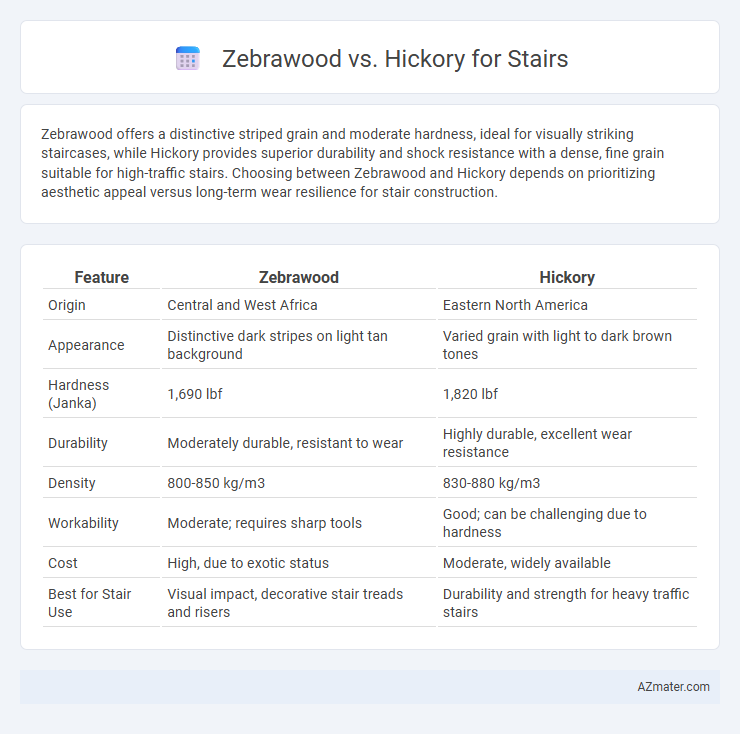Zebrawood offers a distinctive striped grain and moderate hardness, ideal for visually striking staircases, while Hickory provides superior durability and shock resistance with a dense, fine grain suitable for high-traffic stairs. Choosing between Zebrawood and Hickory depends on prioritizing aesthetic appeal versus long-term wear resilience for stair construction.
Table of Comparison
| Feature | Zebrawood | Hickory |
|---|---|---|
| Origin | Central and West Africa | Eastern North America |
| Appearance | Distinctive dark stripes on light tan background | Varied grain with light to dark brown tones |
| Hardness (Janka) | 1,690 lbf | 1,820 lbf |
| Durability | Moderately durable, resistant to wear | Highly durable, excellent wear resistance |
| Density | 800-850 kg/m3 | 830-880 kg/m3 |
| Workability | Moderate; requires sharp tools | Good; can be challenging due to hardness |
| Cost | High, due to exotic status | Moderate, widely available |
| Best for Stair Use | Visual impact, decorative stair treads and risers | Durability and strength for heavy traffic stairs |
Introduction to Zebrawood and Hickory
Zebrawood, known for its striking dark brown to black stripes against a light yellow or tan background, offers a unique and exotic appearance ideal for staircases requiring bold aesthetics. Hickory stands out with its exceptional hardness and shock resistance, featuring a distinctive grain pattern in shades of cream to reddish-brown, making it a durable choice for high-traffic stairs. Both woods provide distinct visual appeal and performance, with Zebrawood emphasizing exotic elegance and Hickory delivering robust strength.
Aesthetic Differences: Grain and Color
Zebrawood features bold, contrasting dark stripes against a light golden to creamy background, offering a striking and exotic visual appeal ideal for staircases seeking a unique statement. Hickory presents a more traditional aesthetic with a varied grain pattern that ranges from straight to wavy and colors shifting from pale beige to warm reddish-brown, providing rich warmth and rustic charm. The distinctively dramatic grain and lighter hue of Zebrawood make it suited for modern or eclectic designs, while Hickory's natural variation and earthy tones complement classic and country-style stair installations.
Durability and Hardness Comparison
Zebrawood offers a hardness rating of approximately 1570 on the Janka scale, making it highly resistant to dents and scratches, ideal for stair treads subjected to heavy foot traffic. Hickory, with a Janka hardness of around 1820, is one of the hardest domestic woods available, providing exceptional durability and impact resistance for stairs. Both woods ensure long-lasting performance, but hickory's superior hardness makes it slightly more durable in high-impact areas.
Cost Considerations for Stair Projects
Zebrawood typically commands a higher price than hickory, primarily due to its exotic status and limited availability. Hickory offers a more budget-friendly option, balancing durability and aesthetic appeal without the premium cost. For stair projects, choosing hickory can significantly reduce material expenses while still providing strong, long-lasting performance.
Maintenance Requirements
Zebrawood staircases require moderate maintenance, involving regular dusting and periodic application of oil or wax to preserve their striking grain pattern and prevent drying out. Hickory stairs demand higher upkeep due to their dense, hard nature; they need frequent cleaning and occasional refinishing to maintain durability and resist dents or scratches. Both woods benefit from humidity control and protective finishes to extend their lifespan and keep stairs looking pristine.
Environmental Impact and Sustainability
Zebrawood and Hickory differ significantly in environmental impact and sustainability, with Zebrawood often sourced from tropical African forests facing deforestation concerns, while Hickory is commonly harvested from North American forests managed under more stringent sustainable practices. Hickory's faster growth rate and availability in certified sustainable forests contribute to a lower ecological footprint compared to Zebrawood, which may involve longer transport distances and habitat disruption. For stair construction, selecting Hickory supports a more sustainable supply chain and reduced environmental degradation.
Installation Challenges and Best Practices
Zebrawood's dense grain structure makes cutting and nailing more challenging, often requiring carbide-tipped blades and predrilling to prevent splitting during stair installation. Hickory, being highly hard and dense, demands slower cutting speeds and sharp tools to ensure clean cuts and secure fastening without damaging the wood fibers. Best practices include acclimating both woods to the indoor environment to minimize warping, using construction adhesive alongside nails or screws for added stability, and employing professional-grade sanding techniques to achieve smooth stair surfaces.
Slip Resistance and Safety Factors
Zebrawood offers moderate slip resistance due to its natural texture, making it a safe choice for stair treads, especially when finished with a non-slip coating. Hickory provides superior slip resistance because of its dense grain and slightly rough surface, enhancing safety on stairs in high-traffic areas. Both woods benefit from proper finishing treatments to maximize slip resistance and reduce the risk of falls.
Popular Design Styles with Each Wood
Zebrawood offers striking, bold patterns ideal for modern and contemporary stair designs, adding a unique visual impact with its dark stripes and vivid grain. Hickory suits rustic, farmhouse, and traditional stair styles due to its durability and warm, varied tones ranging from pale to reddish-brown. Both woods enhance staircases with distinct aesthetics, making Zebrawood a choice for statement pieces and Hickory a versatile option for classic, durable designs.
Final Verdict: Choosing the Right Wood for Your Stairs
Zebrawood offers a unique, exotic grain pattern with high durability suitable for statement staircases, while Hickory provides exceptional strength and shock resistance, ideal for high-traffic areas. Both woods are dense and wear-resistant, but Zebrawood's distinct aesthetics suit modern, bold designs, whereas Hickory blends well with traditional and rustic interiors. Choose Zebrawood for striking visual appeal and Hickory for robust performance and versatility in stair construction.

Infographic: Zebrawood vs Hickory for Stair
 azmater.com
azmater.com